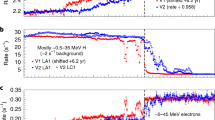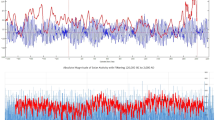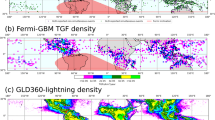Abstract
THE solar diurnal anisotropy of cosmic rays is attributed to the bulk streaming of the cosmic ray gas caused by the corotating interplanetary magnetic field that is “rigidly attached to the Sun”1,2. By analogy with the classical Compton–Getting effect3, a(R), the amplitude of the daily variation at magnetic rigidity R is related to the ratio of particle speed v and the bulk streaming velocity u  where γ is the exponent of the differential spectrum. Because, at the orbit of the Earth, u≈450 km s−1 a neutron monitor with mean rigidity of response about 10 GeV and atmospheric threshold 1 GeV should observe an amplitude extrapolated through the atmosphere to free space of about 0.7 per cent.
where γ is the exponent of the differential spectrum. Because, at the orbit of the Earth, u≈450 km s−1 a neutron monitor with mean rigidity of response about 10 GeV and atmospheric threshold 1 GeV should observe an amplitude extrapolated through the atmosphere to free space of about 0.7 per cent.
This is a preview of subscription content, access via your institution
Access options
Subscribe to this journal
Receive 51 print issues and online access
$199.00 per year
only $3.90 per issue
Buy this article
- Purchase on Springer Link
- Instant access to full article PDF
Prices may be subject to local taxes which are calculated during checkout
Similar content being viewed by others
References
Parker, E. N., Planet. Space Sci., 12, 735 (1964).
Axford, W. I., Planet. Space Sci., 13, 115 (1965).
Compton, A. H., and Getting, I. A., Phys. Rev., 47, 817 (1935).
Parker, E. N., Planet. Space Sci., 15, 1723 (1967).
Duggal, S. P., Pomerantz, M. A., and Forbush, S. E., Nature, 214, 154 (1967).
Nagashima, K., Potnis, V. R., and Pomerantz, M. A., Nuovo Cimento, 19, 292 (1961).
McCracken, K. G., and Rao, U. R., Proc. Intern. Conf. Cosmic Rays (London), 1, 213 (1965).
Faller, A. M., and Marsden, P. L., Proc. Intern. Conf. Cosmic Rays (London), 1, 231 (1965).
Author information
Authors and Affiliations
Rights and permissions
About this article
Cite this article
JACKLYN, R., DUGGAL, S. & POMERANTZ, M. Solar Diurnal Anisotropy of Cosmic Rays. Nature 223, 601–602 (1969). https://doi.org/10.1038/223601a0
Received:
Revised:
Issue Date:
DOI: https://doi.org/10.1038/223601a0
This article is cited by
-
Precursory Signals of Forbush Decreases Not Connected with Shock Waves
Solar Physics (2022)
Comments
By submitting a comment you agree to abide by our Terms and Community Guidelines. If you find something abusive or that does not comply with our terms or guidelines please flag it as inappropriate.



